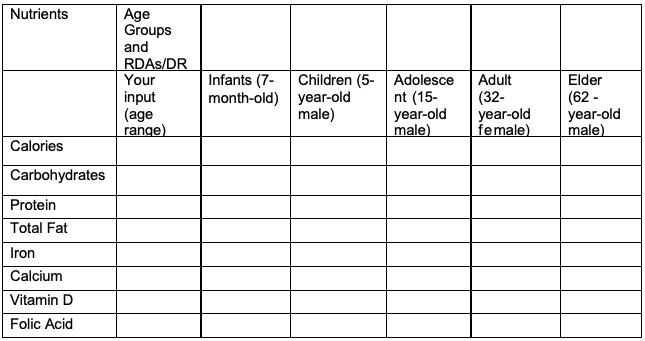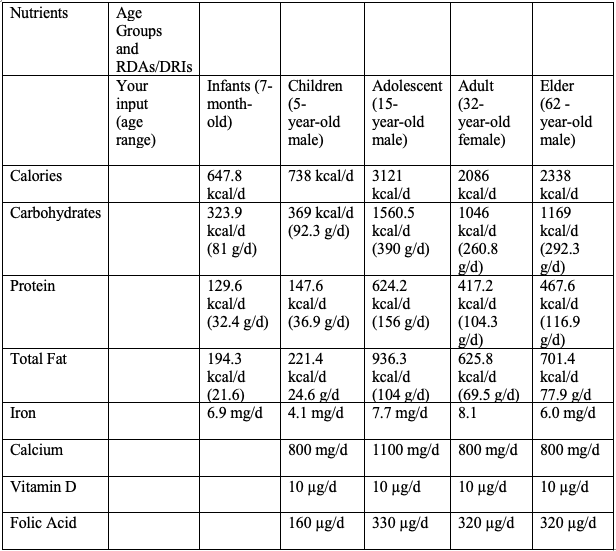Diet Analysis and Comparison across the Life Cycle and Comparison of Food Assistance Programs (Energy Needs)
Unit outcomes addressed in this Assignment:
- Describe the food assistance programs available throughout the lifespan.
- Discuss the eligibility requirements for SNAP and WIC.
- Discuss the advantages and disadvantages of SNAP and WIC.
- Compare SNAP and WIC and their focus on prevention.
Course outcome assessed/addressed in this Assignment:
- NS325-1: Discuss how nutrient needs change throughout the life cycle.
- NS325-6: Identify nutrition education and food assistance programs available to pregnant women, infants, children and the elderly.
- GEL-1.1: Demonstrate college-level communication through the composition of original materials in Standard American English.
Instructions:
This Assignment is divided into two sections. The first section requires you to compare nutrients throughout the life stages. The second section requires you to compare the varying approaches of food assistance programs designed to assist specific populations.
Part I: Nutrients across the Life Cycle
For the first part of your Assignment, complete the table below for total calories, total carbohydrates, protein, total fat, calcium, iron, vitamin D, and folic acid to the RDAs/DRIs of the listed life stages. You will need to determine the energy needs for infants, children, adolescents, adults, and elders. The book has several equations to determine these needs (e.g. kcal/kgBW, Harris- Benedict, Mifflin St-Jeor).
After determining the energy needs, determine the macronutrients in grams. For example, if a child needs 2000 calories, 50% of those calories from carbohydrates, 20% from protein, and 30% from fat; that would be 250 grams carbohydrates, 100 grams protein, and 67 grams fat. Then, use the book or this website (http://fnic.nal.usda.gov/dietary-guidance/dietary-reference-intakes/dri-tables-andapplication-reports) to locate the DRIs for each age group for the micronutrients:
a. Infants (7-month-old female, 26 inches, 18 pounds)
b. Child (5-year-old male, 44 inches, 38 pounds, who runs around at school for about 45 minutes per day)
c. Teen (15-year-old male, 71 inches, 155 pounds, who works out 6 days per week for 60 minutes by playing basketball)
d. Adult (32-year-old female, 63 inches, 123 pounds, who works out 4 days per week for 30 minutes by running on the treadmill)
e. Elderly (62-year-old male, 69 inches, 188 pounds, who walks 1 mile 7 days per week, which is about 40 minutes total each day)
Use the below table to provide the information above for each age group

Choose 1 macronutrient, 1 vitamin, and 1 mineral from the table above. Discuss why these particular nutrients increase/decrease/or remain the same throughout each life stage.
Part II: Comparing WIC and SNAP
The nutrition status and food choices described in part I are influenced by many factors including socioeconomic status, knowledge, and access to healthy foods. In order to meet the nutritional needs you described previously, write an essay comparing WIC and SNAP. Include WIC and SNAP’s eligibility requirements (i.e., income level, risk factors, etc.) and at least two advantages and two disadvantages for WIC and SNAP.
Requirements:
- Comparative essay should be written in paragraph format.
- The viewpoint and purpose of the essay should be clearly established and sustained.
- Be sure to write a clear conclusion for your essay that addresses the key points of your comparative essay.
- Your work should display superior content, organization, style, and mechanics.
- Your writing should be well ordered, logical, and unified, as well as original and insightful.
- Assignment should follow the conventions of Standard American English (correct grammar, punctuation, etc.).
- Follow APA style format and citation guidelines, including Times New Roman 12 point font and double spacing.
- Include a title page and reference page.
- The minimum page limit is 5 pages or 1500 words. Length requirements do not include the title page, reference page, or the appendix for part I.
- Include at least two references. The course textbook counts as one reference. All sources must be scholarly. Wikipedia is an example of a resource that is not acceptable. Use APA style for all citations including course materials.
- For additional support utilize the GEL 1.1 Universal Writing Rubric, the Kaplan Writing Center, and review “Writing Center Resources” in Doc Sharing. The Writing Center provides guidelines for writing essays and comparing and contrasting.
Solution
Part 1

Energy needs
It is clear from the table that the energy needs of individuals vary across the ages. Nevertheless, it is important to note that energy needs are affected by various factors, some of which may not be relevant to age. Among the important determinants of energy needs is the rate of growth or development or the basal metabolic rate (Brown, et al., 2013). It is important to note that the basal metabolic rate of infants is high an aspect that contributes to their high energy needs. Their need for growth leads to an increased demand for energy. The demand for energy increases as the infant grows and heightens upon reaching adolescence when changes related to puberty take place within the body. As an individual enters into adulthood, the daily energy needs start to reduce as they age. Nevertheless, it is important to note that the level of activity that one engages in is an important determinant of energy needs (Brown, et al., 2013). This could explain the high daily energy requirements for the adolescent male presented in the table. The male plays basketball for sixty minutes each day for six days in a week, which is categorized as heavy activity. As such, to compensate the energy expenditure during such a work-out, the energy requirements are high.
Changes in Macronutrients across the Life-cycle
Changes in the requirements for macronutrients are reflective of the changes in the calorie needs across the life cycle. As such, as the aforementioned changes in energy needs rise from infancy to adolescence before starting to drop, so do changes in the requirements for macronutrients. It is important to note that carbohydrates supply 50% of the total energy requirements each day, fats supply 30%, while protein supplies 20% (Sharlin & Edelstein, 2011). This explains the high carbohydrate requirements in the diet across the ages as compared to fats and proteins. Adolescents are at the peak of growth even as changes occur within their bodies as they transit into adulthood. As such, an increase in their energy requirements means that they will have to consume more carbohydrates, which are a major supply of their energy, followed by a higher amount of fats as compared to proteins, as fat are an energy substitute for carbohydrates. Proteins contribute a lower amount of energy as they catabolism to produce energy is in itself energy tasking (Sharlin & Edelstein, 2011).
Changes in Vitamin requirements across the Life-cycle
Vitamins are important to the body for various purposes, including metabolism and facilitating the functioning of other nutrients (Brown, et al., 2013). The requirements for folate as presented in the table rise from childhood to adolescence and then drop into adulthood before leveling out as individuals age. As such, just like in the sections discussed above, it is clear that the increased growth activity during puberty leads to increased requirements for nutrients, including Folic Acid. Folic Acid functions alongside Vitamin C and Vitamin B12 in facilitating the breakdown, creation, and use of new proteins by the body. It also helps in the production of DNA and formation of red blood cells (Sharlin & Edelstein, 2011). The requirements for folate remain high across adulthood as it is a water soluble vitamin that needs to be consumed in meals on a daily basis. Vitamin D on the other hand is required in low amounts even as its requirements is the same across the life cycle since it is a fat soluble vitamin and hence it is stored in the body.
Changes in Mineral requirements across the Life-Cycle
Minerals are required in adequate amounts
to facilitate optimal health (Sharlin & Edelstein, 2011). Calcium
requirements increase from childhood into adolescents and then drop before
stagnating. It is important to note that the requirements for this mineral are
the same across the ages except for the adolescent. This could be attributed to
the increased need for nutrients during this period to facilitate growth.
Part 2
Eligibility Requirements for WIC
The program serves pregnant women during their pregnancy period and postpartum mothers at the end of the pregnancy or six weeks after delivery (USDA, 2016). It also covers breastfeeding mothers up to the first birthday of the infant. Apart from women, other categories covered by the program include infants up to their first birthday and children up to their fifth birthdays. It is also a residential requirement that applicants apply from a State that they live in. in terms of income requirements, the applicants must be having their income levels at or below the State agency set standards. On the other hand, individuals can be deemed automatically-income eligible considering their participation in other programs. Lastly, the applicant must be proclaimed as being at nutrition risk by a physician, nutritionist, or nurse (USDA, 2016).
Eligibility requirements for SNAP
Households are required to either be having $2,250 in countable resources, including a bank account, or $3,250 in countable resources if one of the individuals is aged 60 and above (USDA, 2015). All households must meet the income tests except in cases where the members are recipients of SSI, TANF, or general assistance. Work requirements include not voluntarily reducing hours or quitting a job, registering for work, taking an offered job, and taking part in State assigned training and employment programs. For immigrants, they must have stayed in the country for at least five years, be recipients of disability-related benefits or assistance, or are under 18 years of age (USDA, 2015).
Advantages of WIC
- The WIC program provides low income families with nutritious foods, breastfeeding support, nutrition education, and referrals to social and health care services.
- The program is also advantageous as it does not exclude individuals who are already part of another program. In fact, they are readily considered as income-eligible.
Advantages of SNAP
- SNAP prevents hunger and poverty by targeting the poorest of Americans, mostly those who live below the poverty line.
- The program is highly efficient in responding to emergency disasters.
Disadvantages of WIC
- The breast feeding formula offered by the program is likely to reduce breastfeeding, which is considered as being of greater importance to the infant.
- In most cases, the program has a reduced socio-economic impact as it meets the immediate problem of the recipients and fails to alter behaviors that lead to such problems.
Disadvantages of SNAP
- The program may cause dependency among the recipients and reduce efforts towards promoting socio-economic improvements as adopted by the recipients.
- The criteria are likely to lock out a large number of individuals in need of such help.
References
Brown, J. E. et al., 2013. Nutrition Through the Life Cycle. 5th ed. Stamford: Cengage Learning.
Sharlin, J. & Edelstein, S., 2011. Essentials of Life Cycle Nutrition. Boston: Jones & Bartlett Publishers.
USDA, 2015. Supplemental Nutrition Assistance Program (SNAP). [Online]
Available at: http://www.fns.usda.gov/snap/eligibility#EmploymentRequirements
[Accessed 4 April 2016].
USDA, 2016. Women, Infants and Children (WIC). [Online]
Available at: http://www.fns.usda.gov/wic/wic-eligibility-requirements
[Accessed 4 April 2016].

